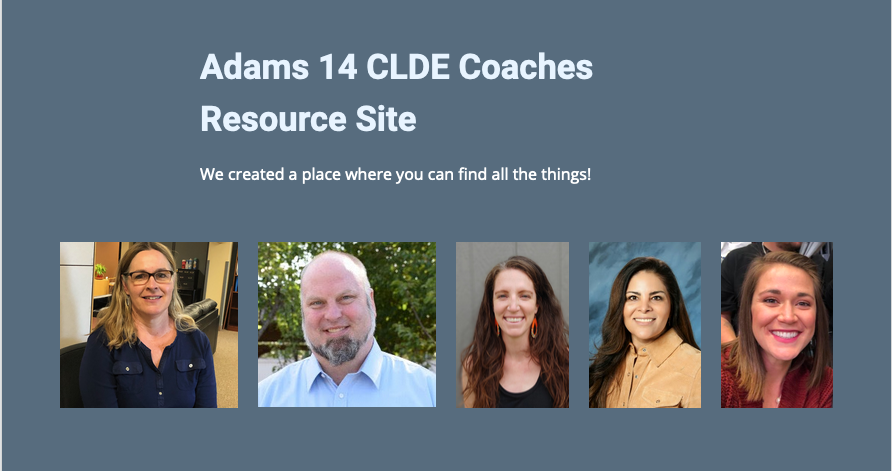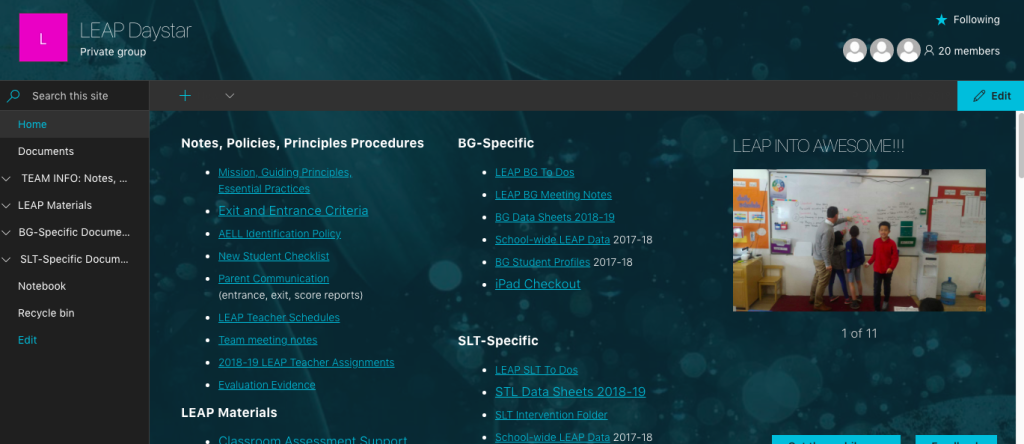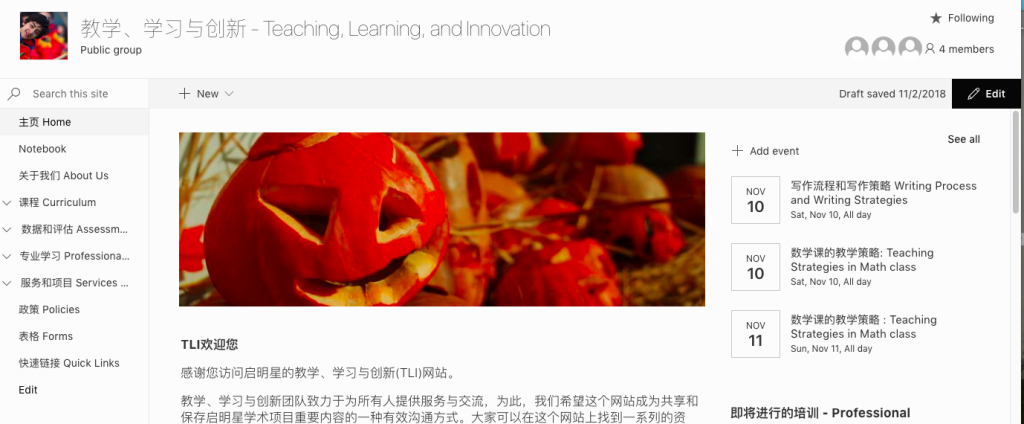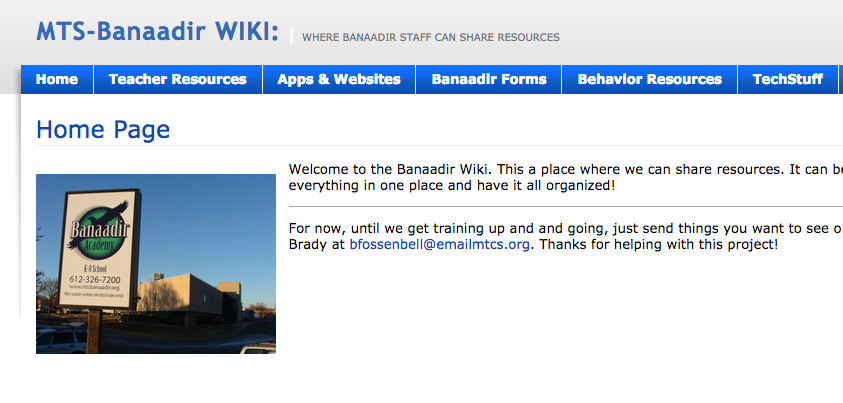Communication
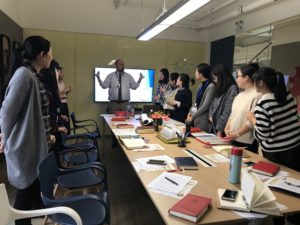 The goal of clear and successful communication naturally lies at the core of language teaching. But beyond the classroom as well, the value of communication in a professional educational setting cannot be overstated. We have moved into an era when the avenues linking instructional staff, leadership, students and families must be dynamic, multidirectional, and fluid. Communication means not only discussing issues with each other, but sharing information and resources, and streamlining the often overwhelming flow of documentation and materials that is part of every educator’s work life. Following are a few of the many ways that I have demonstrated the high value that I place on communication in my role as Language Support Services Coordinator.
The goal of clear and successful communication naturally lies at the core of language teaching. But beyond the classroom as well, the value of communication in a professional educational setting cannot be overstated. We have moved into an era when the avenues linking instructional staff, leadership, students and families must be dynamic, multidirectional, and fluid. Communication means not only discussing issues with each other, but sharing information and resources, and streamlining the often overwhelming flow of documentation and materials that is part of every educator’s work life. Following are a few of the many ways that I have demonstrated the high value that I place on communication in my role as Language Support Services Coordinator.
Team Communication
In the day-to-day world of teaching, there’s hardly time to use the restroom, let alone keep up with the myriad of emails, messages, and requests that teachers receive. This consideration is what prompted me to create the Learning English for Academic Proficiency (LEAP) Team Intranet Site for my team at Daystar Academy and the Adams 14 ELD Coaches Resource Site. They became the one centralized place where team members from three schools can access all of our in-house language support resources, WIDA resources, log-ins, weekly and monthly goals, and more. It houses our internal processes, such as new student checklists, as well as student data and a monthly to-do page with hyperlinked action items. The site has saved everyone time by reducing the number of emails I have to write and that my team members have to sift through when looking for materials or information. Furthermore, by granting the whole team permission to add files, I encouraged them to contribute and collaborate as well. For example, they have created a shared resource library and built a teaching sample video library so that all members can watch each other teach and reflect upon instructional practices across different campuses.
Parent Communication
Research shows that non-native speakers take an average of 4 to 7 years to attain academic English proficiency (Cummins, 1981; Snow, 1987; Collier, 1995). It’s a long journey, but one that can be successfully undertaken with intentional instruction and self-study. Parent support is often a key component to success in this endeavor, so our ELL/EAL team places a high value in communicating with parents.
Coffee Talks
At Daystar Academy, we have a tradition of hosting Coffee Talks – gatherings where we invite parents to come share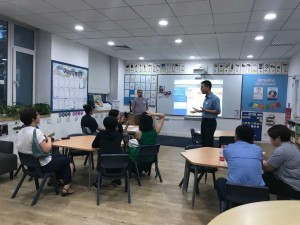 ideas and resources in a casual setting with coffee and food. Over the last several years, our team has hosted dozens of these sessions as a way of opening dialogues about the program, and of exchanging strategies and tools aimed at helping language learners succeed.
ideas and resources in a casual setting with coffee and food. Over the last several years, our team has hosted dozens of these sessions as a way of opening dialogues about the program, and of exchanging strategies and tools aimed at helping language learners succeed.
We’ve learned a lot from each other during this process through activities ranging from phonics games and vocabulary strategies to asking questions while reading and using technology.
Through this process, the school has also seen a definitive uptick in parent involvement, which in turn has noticeably impacted areas such as students’ reading fluency, comprehension and vocabulary usage.
Online Parent Resources
Given that not every parent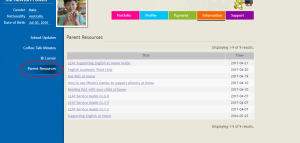 can attend a Coffee Talk, we view it as essential that our parents have a way of accessing session notes and resources. Thus, we additionally place all of our materials into an online resource hub. Parents can download and view programmatic information, bilingual videos, bilingual PowerPoints and handouts, and go over them with their children or with each other.
can attend a Coffee Talk, we view it as essential that our parents have a way of accessing session notes and resources. Thus, we additionally place all of our materials into an online resource hub. Parents can download and view programmatic information, bilingual videos, bilingual PowerPoints and handouts, and go over them with their children or with each other.
Parent Newsletters and Content Previews
As a part of our parent outreach, we also send home semi-monthly newsletters that overview student learning engagements and various supports being used. We send out previews of the next week’s lesson as well, including vocabulary words, background knowledge videos, and an abridged reading or summary, in addition to the unit overview. This has led to students being more prepared to start the week as they come to class on Monday already having some background information on the subject, as well as a general understanding of the reading. Students often come in on Mondays comparing original self-generated definitions and sentences using the Tier 2 vocabulary of the week.
Department Communication
TLI Intranet Site
Following on the success of the LEAP intranet site, the executive director of Teaching Learning and Innovation (TLI) and I decided to build an intranet site for the entire TLI department at Daystar. The scale of this site is quite a bit more extensive, as it supports all teachers in three schools and in two languages. With such varied needs, we had to devise differing levels of access for such documents as Individualized Support Plans (ISPs) and student assessment data. We did so using the Office Sharepoint platform, and the resulting TLI intranet site has become the one-stop shop in our district for student data, curriculum resources, assessment resources, policies and internal documentation for students with special needs and language learners. Teachers have told us it saves them a lot of time and that they also feel more supported with the resources made easily available to them.
Program Overview Graphic
As a bilingual immersion school running a full Chinese national curriculum, alongside US Common Core standards as an International Bac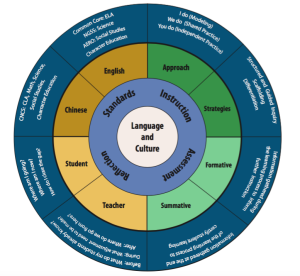 calaureate school, Daystar’s academic approach has many moving pieces and can be confusing to stakeholders. To help clarify how the components of our program fit together, I co-created, along with the executive director of TLI and our curriculum director, a visual representation of our entire educational model. I dusted off my graphic design skills and created this infographic based on our team sketches. The design has helped show the alignment of our four focuses of Standards, Instruction, Assessment and Reflection, and how they holistically relate to the various components of the program. I’m proud to say that the resulting graphic has proven so useful in illustrating and explaining our model that it is now used by our admissions department at open houses, as well as in board meetings and new hire orientation sessions.
calaureate school, Daystar’s academic approach has many moving pieces and can be confusing to stakeholders. To help clarify how the components of our program fit together, I co-created, along with the executive director of TLI and our curriculum director, a visual representation of our entire educational model. I dusted off my graphic design skills and created this infographic based on our team sketches. The design has helped show the alignment of our four focuses of Standards, Instruction, Assessment and Reflection, and how they holistically relate to the various components of the program. I’m proud to say that the resulting graphic has proven so useful in illustrating and explaining our model that it is now used by our admissions department at open houses, as well as in board meetings and new hire orientation sessions.
Banaadir Academy Resource WIKI
In 2011, Banaadir Academy (Minneapolis) was a new charter school just getting off the ground. As is often the case, it was full of talented, passionate teachers coming with great ideas and a slew of useful resources. In fact, so many good materials were being shared back and forth that teachers were overwhelmed and, as a result, didn’t use them. There was also no clear place to find things like time off requests and incident reports. Identifying this need, I worked with the principal to develop the Banaadir Resource WIKI. Teachers were able to share apps and websites, supplementary resources and behavior notes with each other in one place. Admin was also able to post relevant forms and tech support documentation. The site grew as teachers used it and it became and remained one of the primary communication tools for the school.
